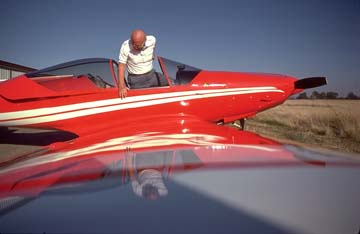From the very beginning, the Falco was designed for speed. The cowling
is graceful, smooth and slender. The fuselage is a sculpture of flowing,
wind-cheating contours. The laminar-flow wing is smooth as a mill pond on
a windless day.
The top speed is 212 mph, and the cruise is 190 mph -- on just 160 hp. Add
gear doors, gap seals, hinge fairings and a host of other tiny improvements,
and the Falco will cruise at 200 to 210 mph.
It's efficient, too. Fuel efficiency is unequalled at some 25 miles per
gallon, giving an ultimate range of approximately 1,000 miles.
The power loading is only 11.3 pounds per horsepower, which accounts
for the rate of climb of 1,150 feet per minute. Normal landings and takeoffs
require only 1,150 feet to clear a 50-foot barrier. And the service ceiling
is 19,000 feet.
All this performance is impressive, but there is more to the story than
the simple numbers. Today, some homebuilt designs equal or exceed the speed
of the Falco, but there is a big difference.
First there are the notoriously exaggerated performance claims of homebuilts.
Everyone claims 200 mph cruise -- even for Volkswagen-powered planes. We've
had a stock Falco fly with a '220 mph' homebuilt, and the airplanes flew
at exactly the same speed.
Most homebuilts are tiny airplanes, with Thumbalina wings and undersized
tail surfaces. But a tiny wing produces a hot airplane, a sharp stall and
a high landing speed. A small tail creates low-speed handling problems and
limits cross-wind capability. And tiny airplanes have touchy, squirrelly
handling. Most homebuilts have tiny air inlets for the engine, sufficient
for cruising, but unable to climb on hot days. And almost all have small,
cramped cockpits, little luggage capacity and a limited useful load. Performance
at a price.
The Falco has none of this. The wing area is ample, producing a moderate
stall and superb high-altitude performance. The tail surfaces are sufficient
for 20 knot cross-winds. The low-speed stability is excellent, and the handling
is legendary. The Falco engine is tightly cowled, but the inlets are large,
so the engine runs at normal temperatures. You can easily climb on hot days.
And most importantly, the Falco has a roomy cockpit, comfortable seats
and plenty of room for luggage. And a load-it-to-the-gunwales carrying capacity.
The Falco is a real airplane. It achieves high performance from brilliant
aerodynamics and solid design, not compromises. |
![]()
